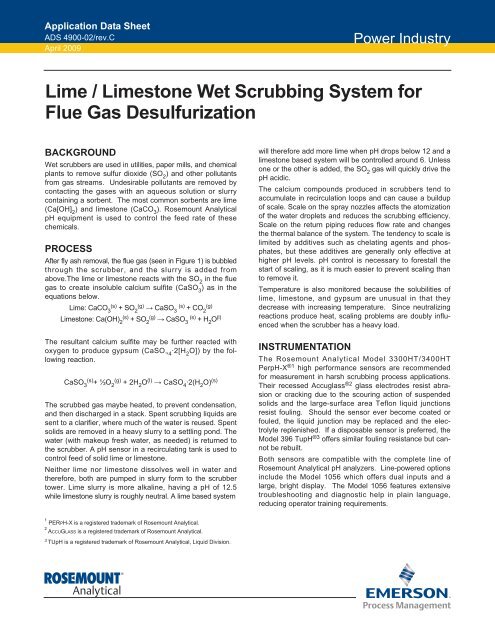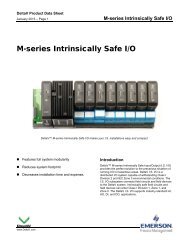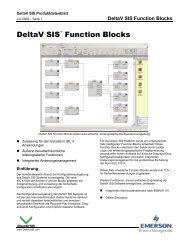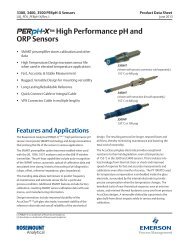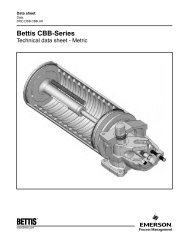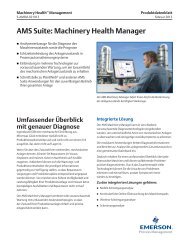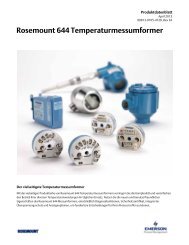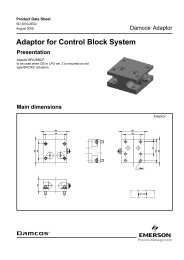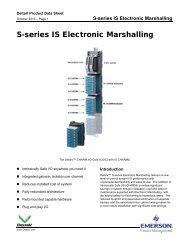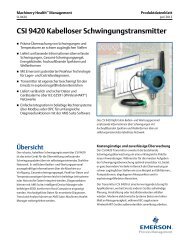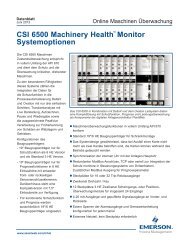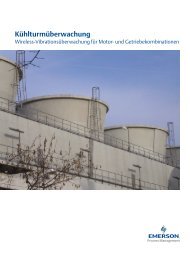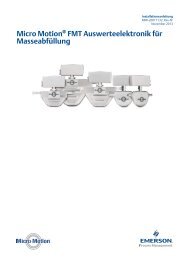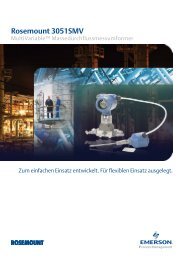Lime/Limestone Wet Scrubbing System for - Emerson Process ...
Lime/Limestone Wet Scrubbing System for - Emerson Process ...
Lime/Limestone Wet Scrubbing System for - Emerson Process ...
You also want an ePaper? Increase the reach of your titles
YUMPU automatically turns print PDFs into web optimized ePapers that Google loves.
Application Data Sheet<br />
ADS 4900-02/rev.C<br />
April 2009<br />
<strong>Lime</strong> / <strong>Lime</strong>stone <strong>Wet</strong> <strong>Scrubbing</strong> <strong>System</strong> <strong>for</strong><br />
Flue Gas Desulfurization<br />
BACKGROUND<br />
<strong>Wet</strong> scrubbers are used in utilities, paper mills, and chemical<br />
plants to remove sulfur dioxide (SO 2 ) and other pollutants<br />
from gas streams. Undesirable pollutants are removed by<br />
contacting the gases with an aqueous solution or slurry<br />
containing a sorbent. The most common sorbents are lime<br />
(Ca[OH] 2 ) and limestone (CaCO 3 ). Rosemount Analytical<br />
pH equipment is used to control the feed rate of these<br />
chemicals.<br />
PROCESS<br />
After fly ash removal, the flue gas (seen in Figure 1) is bubbled<br />
through the scrubber, and the slurry is added from<br />
above.The lime or limestone reacts with the SO2 in the flue<br />
gas to create insoluble calcium sulfite (CaSO3 ) as in the<br />
equations below.<br />
<strong>Lime</strong>: CaCO (s)<br />
3 + SO2 (g) → CaSO3 (s) + CO2 (g)<br />
<strong>Lime</strong>stone: Ca(OH) 2 (s) + SO2 (g) → CaSO3 (s) + H2 O (l)<br />
The resultant calcium sulfite may be further reacted with<br />
oxygen to produce gypsum (CaSO ¬4 ·2[H 2 O]) by the following<br />
reaction.<br />
CaSO 3 (s) + ½O2 (g) + 2H2 O (l) → CaSO 4 ·2(H 2 O) (s)<br />
The scrubbed gas maybe heated, to prevent condensation,<br />
and then discharged in a stack. Spent scrubbing liquids are<br />
sent to a clarifier, where much of the water is reused. Spent<br />
solids are removed in a heavy slurry to a settling pond. The<br />
water (with makeup fresh water, as needed) is returned to<br />
the scrubber. A pH sensor in a recirculating tank is used to<br />
control feed of solid lime or limestone.<br />
Neither lime nor limestone dissolves well in water and<br />
there<strong>for</strong>e, both are pumped in slurry <strong>for</strong>m to the scrubber<br />
tower. <strong>Lime</strong> slurry is more alkaline, having a pH of 12.5<br />
while limestone slurry is roughly neutral. A lime based system<br />
1<br />
PERPH-X is a registered trademark of Rosemount Analytical.<br />
2<br />
ACCUGLASS is a registered trademark of Rosemount Analytical.<br />
3 TUpH is a registered trademark of Rosemount Analytical, Liquid Division.<br />
will there<strong>for</strong>e add more lime when pH drops below 12 and a<br />
limestone based system will be controlled around 6. Unless<br />
one or the other is added, the SO2 gas will quickly drive the<br />
pH acidic.<br />
The calcium compounds produced in scrubbers tend to<br />
accumulate in recirculation loops and can cause a buildup<br />
of scale. Scale on the spray nozzles affects the atomization<br />
of the water droplets and reduces the scrubbing efficiency.<br />
Scale on the return piping reduces flow rate and changes<br />
the thermal balance of the system. The tendency to scale is<br />
limited by additives such as chelating agents and phosphates,<br />
but these additives are generally only effective at<br />
higher pH levels. pH control is necessary to <strong>for</strong>estall the<br />
start of scaling, as it is much easier to prevent scaling than<br />
to remove it.<br />
Temperature is also monitored because the solubilities of<br />
lime, limestone, and gypsum are unusual in that they<br />
decrease with increasing temperature. Since neutralizing<br />
reactions produce heat, scaling problems are doubly influenced<br />
when the scrubber has a heavy load.<br />
INSTRUMENTATION<br />
Power Industry<br />
The Rosemount Analytical Model 3300HT/3400HT<br />
PerpH-X ®1 high per<strong>for</strong>mance sensors are recommended<br />
<strong>for</strong> measurement in harsh scrubbing process applications.<br />
Their recessed Accuglass ®2 glass electrodes resist abrasion<br />
or cracking due to the scouring action of suspended<br />
solids and the large-surface area Teflon liquid junctions<br />
resist fouling. Should the sensor ever become coated or<br />
fouled, the liquid junction may be replaced and the electrolyte<br />
replenished. If a disposable sensor is preferred, the<br />
Model 396 TupH ®3 offers similar fouling resistance but cannot<br />
be rebuilt.<br />
Both sensors are compatible with the complete line of<br />
Rosemount Analytical pH analyzers. Line-powered options<br />
include the Model 1056 which offers dual inputs and a<br />
large, bright display. The Model 1056 features extensive<br />
troubleshooting and diagnostic help in plain language,<br />
reducing operator training requirements.
INSTRUMENTATION<br />
Model 3300HT/3400HT PerpH-X pH/ORP<br />
Sensor<br />
• Long lasting, rebuildable reference <strong>for</strong><br />
lowest total cost of ownership<br />
• High temperature design resists<br />
per<strong>for</strong>mance degradation due to<br />
temperature cycling.<br />
• Rugged, versatile design available in a variety of<br />
installation and material configurations<br />
• Customizable reference fill solutions resist scaling<br />
or poisoning.<br />
Model 1056 Dual Input Intelligent<br />
Analyzer<br />
• Dual configurable inputs and outputs<br />
• Large, bright LCD display<br />
• Intuitive menus with advanced<br />
diagnostics<br />
• 4 alarm relays with timers<br />
• Optional HART ®4 or Profibus ®5 DP<br />
• Polycarbonate NEMA 4X (IP65) enclosure<br />
FLUE<br />
GAS<br />
Ca(OH) 2 or<br />
CaCO 3<br />
SCRUBBER<br />
RECIRCULATING TANK EFFLUENT TANK<br />
<strong>Emerson</strong> <strong>Process</strong> Management<br />
Rosemount Analytical Inc.<br />
2400 Barranca Parkway<br />
Irvine, CA 92606 USA<br />
Tel: (949) 757-8500<br />
Fax: (949) 474-7250<br />
http://www.raihome.com<br />
© Rosemount Analytical Inc. 2009<br />
REHEATER<br />
Solu Comp Model Xmt-P pH/ORP<br />
• Two-wire transmitter<br />
• Optional HART or FOUNDATION ®6<br />
Fieldbus<br />
• Polycarbonate NEMA 4X (IP65)<br />
enclosure<br />
CLARIFIER<br />
FIGURE 1. <strong>Scrubbing</strong> <strong>System</strong> <strong>for</strong> Boiler Flue Gas<br />
Model 396P/396R TUpH pH/ORP<br />
Sensor<br />
• Patented polypropylene reference junction<br />
and patented helical pathway mean<br />
longer sensor life in process solutions<br />
containing heavy solids.<br />
• Disposable one-piece construction is convenient and economical<br />
where minimal troubleshooting and maintenance<br />
downtime are of prime importance.<br />
• Patented helical pathway to prevent sulfide poisoning.<br />
• Suitable <strong>for</strong> flow-through and submersion applications.<br />
4 HART is a registered trademark of the Hart foundation<br />
5 Profibus is a registered trademark of Profibus & Profinet International<br />
6 FOUNDATION Fieldbus is a registered trademark of the Fieldbus Foundation<br />
MAKE-UP<br />
WATER<br />
MAKE-UP<br />
HOLD<br />
TANK<br />
STACK<br />
TO SETTLING POND


